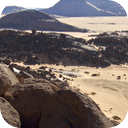(short preview of full seamless looping track)
(short preview of full seamless looping track)
(short preview of full seamless looping track)
(short preview of full seamless looping track)
(short preview of full seamless looping track)
Desert Mountain Top Wind
This product is not available in the selected currency.
In Stock
Backordered
Out of Stock
Description
Standing upon the house of the Gods, from this powerful position a heavenly view spans the horizon like nowhere else. The heights summon the spirits of ancient masters and miscreant marauders that swim through your hair, blowing wildly the very roots of your being. As you stretch your arms wide, willing to embrace whatever vision occurs, you feel the wind lift you off your feet. English desert and its Romance cognates (including Italian and Portuguese deserto, French désert and Spanish desierto) all come from the ecclesiastical Latin dēsertum (originally "an abandoned place"), a participle of dēserere, "to abandon." The correlation between aridity and sparse population is complex and dynamic, varying by culture, era, and technologies; thus the use of the word desert can cause confusion. In English prior to the 20th century, desert was often used in the sense of "unpopulated area", without specific reference to aridity; but today the word is most often used in its climate-science sense (an area of low precipitation)—and a desert may be quite heavily populated, with millions of inhabitants. Phrases such as "desert island" and "Great American Desert" in previous centuries did not necessarily imply sand or aridity; their focus was the sparse population. However, the connotation of a hot, parched, and sandy place often influences today's popular interpretation of those phrases. Deserts take up about one fifth (20%) of the Earth's land surface.
Opps
Sorry, it looks like some products are not available in selected quantity.



